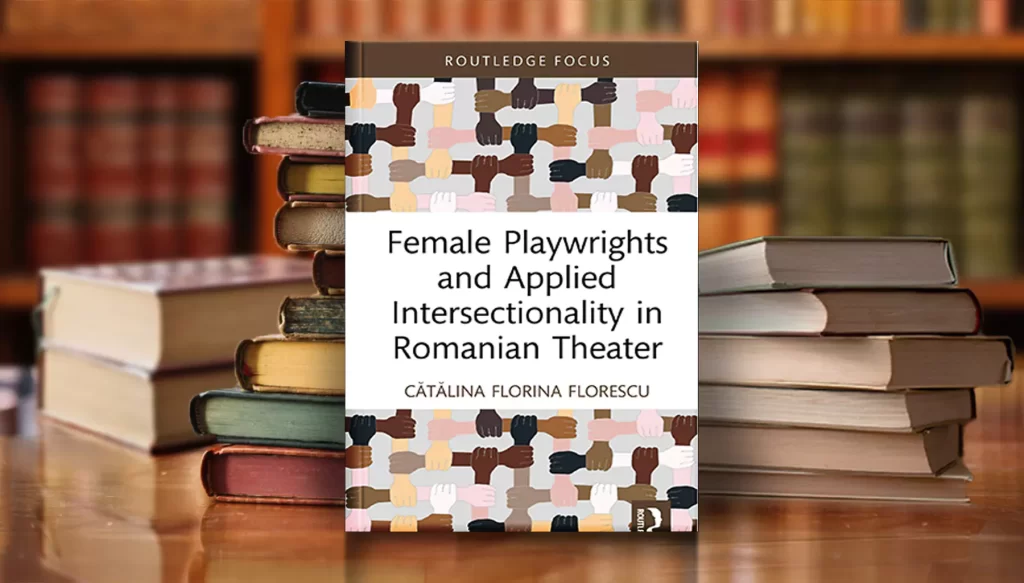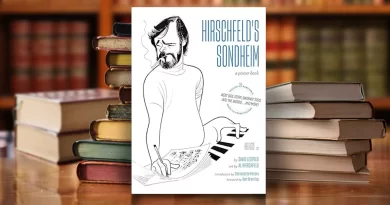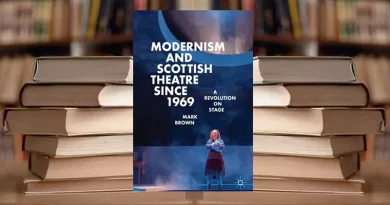“Female Playwrights and Applied Intersectionality in Romanian Theater” by Catalina Florina Florescu
New York. Routledge, 129 pages.
Reviewed by Dana Rufolo
Catalina Florina Florescu is a Romanian scholar who emigrated to the United States, pursued a doctorate in Medical Humanities and is currently a professor at Pace University in New York and also a playwright.
Female Playwrights and Applied Intersectionality in Romanian Theater (Routledge 2024) is an academic book that introduces ten Romanian female playwrights’ plays and how they play tic-tac-toe with the keystones of intersectionality (as defined in 1989 by Crenshaw): race, sex, gender, status quo, immigration status, and differently able body. The plays selected are feminist. Intended to introduce Romanian playwrights into the American school curriculum, this book offers two unusual additional sections to each of the ten critical analyses: “In Their Own Words” where the playwright herself speaks about the history and motivation in writing the play, and “Activities” which are writing exercise suggestions intended to be used in a classroom by the teacher or professor.
The ten plays discussed in the book add considerably to contemporary debates on whether theatre has a social function in the presently micromanaged western world. They deal with what the playwright Mihaela Michailov has called “harsh realities”. In the Realpolitik of today’s emotions and aspirations, these plays testify to a female sensitivity to showing the audience how the drama in everyday situations is fraught with tension and disease.
Female discomfort with the female body and the role of women is signposted by a shared attitude towards children in these plays. They are not seen as part of an intergenerational pattern, nor are they invested with a sure future in which the process of self-actualization can occur. Children are viewed from the angle of an uncertain future.
Florescu has given us a book that focuses on the intellectual intentions of the playwrights reviewed and not on the performance aspects of their plays. Each of the ten plays has been staged, and one black-and-white photo from the premiere performance is always included. However, the theatrical techniques used to give the play a sense of life on the stage are not discussed. This leaves one with the sense that they are more dramas of ideas than of action, but this could be a misleading assumption.
In case a reader is considering staging one of these plays or using them in a classroom situation, the following is a brief summary of each of the plays Florescu discusses.
1.
Wilk says, “We are raised in a patriarchal society and this way of thinking has shaped our views.” Her biggest resentment is against the pressure put on women to start a family as soon as they are 25 years old.
Florescu’s suggested activity for the classroom is to write a 300-word essay on something you wanted badly but “for reasons outside of your control, it did not” happen.
2.
The play by Alexa Băcanu, Pisica Lui Schrödinger (Schrödinger’s Cat), is an interrogation on the nature of depression and the absurdity of life. It was performed in Un Teatru theatre in Bucharest in 2018. The protagonist Lumi is turning 30 and maintains a happy face for her friends’ surprise party, but she finds little joy in life. Everyone wants something from her, and all are unaware that she is preoccupied by trauma and sad memories. She hasn’t a chance to “restart” her life.
Bacanu is pulled in many directions as a playwright, sensing contradicting voices, and she asks herself if she would “still think and feel” as she does if she had been a man.
An activity proposed to accompany reading this play in class is to actively demand community leaders to investigate why women suffer more depression and trauma than do men.
3.
The third play reviewed is an extremely important testimonial to the secondary effects of Nicolae Ceaușescu’s dictatorship. Written by Carmen-Francesca Banciu, a Romanian author who emigrated to Berlin after the fall of the dictator’s regime in 1989 and who wrote the play – based on her autobiographical novel, in German, Ein Land Voller Helden (A Land full of Heroes) – shows how the Securitate, Romania’s secret police, interrogated Maria endlessly to expose her attraction to western thought, causing permanent severance between the daughter Maria and her parents, particularly her father who lost his job in the communist party because of her supposed disloyalty to the state and who never forgave her for this. She also discusses how communist thought prevailed in her home so that even plastic flowers were considered a waste of money. She was not allowed to sing at home or even in school and was made to wear clothes that were unattractive on her.
Banciu says her play explores “the intertwining of the political and the private realms under dictatorship”.
Since Banciu states that women must cease to see themselves as victims, an activity is to interview two women who have rejected victimhood.
4.
Mihaela Drăgan’s play Romacen – Vremea vrăjitoarei (Romacene: The Age of the Witch) was developed during Drăgan’s residency in the Royal Court Theatre in London, as a Roma playwright. Her play is a stand against the absence of comment on the Roma extermination during the Holocaust and the racism traditionally applied to the Roma people. In it, techno-witches – science fiction female witches that are reminiscent of the Wicca – hack Brexit. The women techno witches are tempted to escape into virtual reality and never return to life as it is now. Drăgan’s final message is that racism should become legally punishable as a hate crime.
Drăgan states that her play urges “the creation of a feminist ant-racist society of Roma women based on solidarity”.
Two proposed classroom activities are to research the Roma people and to bring in an artefact that is seldom associated with museum collections and art history studies.
5.
Pulvérisés is a play by Alexandra Badea who lives in France. According to Florescu, it talks about the “damaging side-effects of globalization” that we have all noticed but which are seldom discussed. Badea’s play brings up the fact that more and more cities are interchangeable in respect to the shopping possibilities and lesser-known losses, such as physical connection between family members. She suggests that the idea of “aiming for excellence” which is so popular in international businesses and organizations erodes the human need to live an experiential life with time to be one’s self and with one’s own thoughts and feelings. In the end, the international worker is torn by so many different impulses to achieve perfection that he or she is ultimately dehumanized or pulverized. Pulvérisés was staged in London at the Arcola Theatre in 2017.
Badea states that her play is intended to make us aware of how work was becoming assimilated into people’s daily life, so there was no time left for personal things or feeling pleasure. She is aware that when she writes in French she is using “a language with a strong colonialist history”.
The activities proposed in connection with reading this play include finding one of one’s own self-harming habits and trying to understand why you have this habit: share your analysis in a group.
6.
The play Moss (Verde Crud), by Catalina Florina Florescu herself, was staged at the Players Theatre in New York city in 2020. It exposes the cruelty of imposing re-education – or reparative therapy as it was called in Romania during the dictatorship – on people who have naturally chosen a same-sex partner. A grandmother who was sexually abused in a heterosexual arranged marriage and who then became a sex worker (or such is the implication) tells her granddaughter that she had once been in a lesbian relationship based on love. She had been too afraid of her family’s judgement to come out, and so she lost her female lover forever.
Since Florescu discusses her play and its intentions in the first section, there is no additional section about the playwright’s intentions.
For the activities, it is suggested to form a group and tell some truths about one’s body but also a falsehood. The game is for the others to identify the falsehood. Once this game is over, the group should devise a play about the game they just played.
7.
Hai, Să Vorbim Despre Viață! (Let’s Talk About Life!) is a play for one woman character written by Ana Sorina Corneanu that was performed in the Bucharest National Theatre in 2019. It opens with Greta waiting for the Bolshoi Ballet Company to telephone her and ask her to dance in Swan Lake; this is just a fantasy, she has no pending contract with the ballet company. As Greta must adjust to the unreality of her expectation and reconcile herself to working for a living, she asks existential questions as to whether she can live an authentic life. Or is she too filled with the expectations and voices of others around her to ever arrive at authenticity? Greta asks her alter-ego 69 questions to which she replies, but she is never able to draw a conclusion as to the meaning of her life.
Badea states that “we are not numbers, colours, patterns, but persons who have stories to live and tell.” She believes that a “new normal must be fair for all.”
The exercises for students include developing different ways of interacting with a song of their choice and then writing down how they responded to these various methods and making a quilt to honour two women who were brave enough to pursue their dreams.
8.
Familia Offline (Offline Family) by Mihaela Michailov is an engaged play that shows a clan of children, sisters and brothers, raising themselves, because their mother is working in the West to earn enough money for her family to survive back in Romania. The play reflects the reality that many Romanians became migrant workers in Europe after the fall of the dictatorship in 1989 when the country’s economic situation was extremely precarious. The children are “mothered” by the eldest daughter, Crista, and they are so directionless that they don’t even attend school regularly. There is a grandfather living with them, but he is old and incapable of caring for them. There are no state systems of care in place.
Michailov is an important Romanian playwright who was a co-founder of Replika, a performance space in Bucharest devoted to showcasing experimental dramas. She expresses herself clearly and directly, with the intention of provoking thought leading to social change. This play addresses the “detrimental consequences of work migration”. She states that poor migrants forced to leave family and country can find only “poorly paid jobs” where they work “under questionable conditions”. As well, “they are also dehumanized by the citizens of the respective countries as if their lives had no meaning.”
The first proposed activity is to volunteer in a hospice, a shelter for the homeless or an orphanage for a month, keeping a journal the entire time. The second activity is to find a synonym for the word “abandon” and find and perform five sensory reactions to the word.
9.
Exile is My Home by Domnica Rădulescu is subtitled A Sci-fi Immigrant Fairy Tale. It has Lina and Mina, the two main characters in Exile is My Home, carrying around with them a miniature folding house. Anywhere the house is set up functions as a sort of home for them. However, they never stop anywhere for good, because they are searching for a home that feels right. They visit various geographically imagined places: first planet, second planet and Planet America, and along the way meet many people living outside their original homes such as a taxi driver from Uzbekistan.
Rădulescu, herself a political refugee from Romania when it was a dictatorship, states that her play stems from her research of the “genocidal war of the Balkans” and “assimilated stories … of loss and violent displacements”. She sees the characters of her play creating “utopian worlds where refugees are the heroes”.
One of the two activities proposed is to turn a small section of the play which has been translated into Italian back partially into a bilingual text so as to recognize the effect of not completely knowing a language and having to guess at meanings. The second activity is to find articles about immigration and motherland and search for a link between these two charged words.
10.
Aliens With Extraordinary Skills (Extratereștrii Cu Puteri Supranaturale) by Saviana Stănescu depicts Nadia who works as a clown entertaining children at birthday parties. She comes from Moldova where her family were clowns so her background is highly professional. She is haunted by the fear of receiving a letter telling her she is being deported and must leave the United States. Immigrations officers interrogate her and, for reasons that are not entirely clear, she understands her skills are less important than her sexual appeal. She goes to perform at a party in Soho and is raped there. Her friend Lupita tells her to play it cool, take a morning-after pill, and say nothing, as otherwise she might lose her green card and be deported. Nadia follows her friend’s advice. The play was staged in New York in 2008.
Stănescu arrived in New York in 2001 as a grad student but received the right to remain in America with a visa for “aliens with extraordinary abilities in the arts”. She is convinced that “immigrants often experience that fear of not belonging, of being THE OTHER: a stranger, a foreigner with a funny accent …who “doesn’t deserve” to be in the US.” For her, theatre should promote social change and justice.
Activities include familiarizing one’s self with Ellis Island and rewriting a description of a devastating incident so that the outcome empowers women.
This concludes the summary of the plays Florescu reviewed in Female Playwrights and Applied Intersectionality in Romanian Theater. As to her own motivation in writing the book, in an email she said the following: “Female playwrights from Eastern Europe are a rarity both in academic circles/curricula and on stage. So, I decided to focus exclusively on Romanian female playwrights not because I am a woman but mostly because of my deep connections with that linguistic space. One goal is to make audiences (readers, spectators, educators, etc.) discover ten Romanian female authors and continue to do so with other heavily marginalized writers. This way, hopefully, we diversify the very layered body of global dramatic literature. Another goal is to put Romanian female playwrights on the global dramatic literature map, especially in the States where our voice is barely allowed to exist.”









